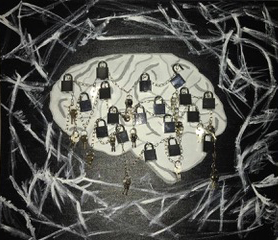Enslaved Mind
The locked up brain represents a narrative familiar to many of us, some who aware of it and others who are not. The narrative being that, we can all be a slave to our mind. This can be applicable to daily moments of life or can be magnified in common mental disorders such as depression and anxiety.
The centrality of the brain depicts the governance our mind can have over our thought processing and actions thereof.
The background of the painting is an abstract version of Ca-dependant fluorescent dye loaded into the neurones. Each lock has been drilled in to the mind and has the matching key attached nearby, which can unlock it.
One of the locks is unlocked already, representing that, through different stimuli, mediums and even people, our minds can be unlocked, the tension and restrictive nature of our thoughts can be released and creativity and pleasure can be born thereof.

I feel that this artwork is especially pertinent to me as I can recognise the symptoms of society in stress and overwork being signified through the locks. What is so uplifting is that the key to free one from their challenges is always so close, and all that one has to do it reach for it.
I like this piece because it has an essence of hope because the locks and keys represent that even if someone is struggling with mental health disorders this does not mean they will always be like this (locked up) as they can get assess to help (the keys).
Just like people are connected, the thoughts that run through our minds (no matter the scale) are all connected and network through one another. Some days the answers (keys) will be right there and easy to locate. Other days, the same thoughts (locks) are locked – you know that there is a key somewhere because you remember the last time the thought arrived, you just can’t remember where you left the key.